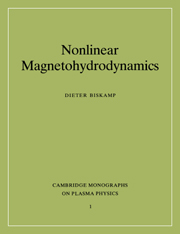Book contents
- Frontmatter
- Contents
- Preface
- 1 Introduction
- 2 Basic properties of magnetohydrodynamics
- 3 Magnetostatic equilibria
- 4 Normal modes and instability
- 5 Nonlinear evolution of MHD instabilities
- 6 Magnetic reconnection
- 7 MHD turbulence
- 8 Disruptive processes in tokamak plasmas
- 9 Dynamics of the reversed-field pinch
- 10 Solar flares
- Outlook
- References
- Index
8 - Disruptive processes in tokamak plasmas
Published online by Cambridge University Press: 15 December 2009
- Frontmatter
- Contents
- Preface
- 1 Introduction
- 2 Basic properties of magnetohydrodynamics
- 3 Magnetostatic equilibria
- 4 Normal modes and instability
- 5 Nonlinear evolution of MHD instabilities
- 6 Magnetic reconnection
- 7 MHD turbulence
- 8 Disruptive processes in tokamak plasmas
- 9 Dynamics of the reversed-field pinch
- 10 Solar flares
- Outlook
- References
- Index
Summary
Tokamaks constitute the best plasma physics laboratory available today. The largest devices (e.g. JET and DIII-D) confine plasmas of considerable volume (many m3), high densities (ne ∼ 1020 m-3) and high temperatures (Te ∼ 10 keV) under quasi-stationary conditions (for an introduction to the general physics of tokamaks see Wesson, 1987). Tokamak plasmas exhibit a rich variety of MHD phenomena, being investigated by numerous diagnostic tools with high spatial and temporal resolution, which make theoretical interpretation a challenging task.
Particularly conspicuous MHD effects are the different kinds of disruptive events which affect global plasma confinement more or less severely. In this chapter we consider the three most important disruptive processes. Section 8.1 deals with the sawtooth oscillation, a quasi-periodic internal relaxation process, which is observed in most tokamak discharges. Their main effect is to limit the central temperature increase, generating a more uniform average temperature distribution. They also have the beneficial effect of preventing the central accumulation of impurity ions.
Section 8.2 considers major disruptions, which constitute the most violent processes in a tokamak plasma. Disruptions occur when certain limits in the plasma parameters are exceeded, causing loss of a large fraction of the plasma energy, which often leads to the termination of the discharge.
- Type
- Chapter
- Information
- Nonlinear Magnetohydrodynamics , pp. 239 - 288Publisher: Cambridge University PressPrint publication year: 1993
- 1
- Cited by



